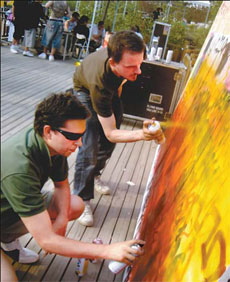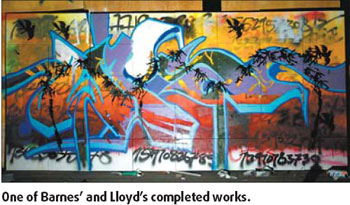| Home / Living in China / Life in Pictures | Tools: Save | Print | E-mail | Most Read |
| Painting the Town Red |
| Adjust font size: |
Martin Barnes creates graffiti art in For someone who intended to treat his trip to A few weeks ago, Barnes and his spray-painting partner, fellow Brit, Dicken Lloyd, were invited to paint a piece at the gastronomy fair, Aperitif a This was not the first time they'd brought this kind of performance art to a big event; earlier this year, they spray-painted a huge canvas in front of curious onlookers at the "That (Aperitif a It's lucky then, that the materials they use don't break the bank. In fact, both artists say that the low price of canvasses and paints in
Martin Barnes (right) and his spray-painting partner, Dicken Lloyd. Barnes said: "I used to go to art shops back home and see how expensive the art materials were and then saw how inexpensive they are over here, and thought, 'We gotta use some of this stuff, because we don't want to miss out on the opportunity', and when we got talking it seemed like the most logical thing to put them together." After meeting through a friend, the pair bonded through a mutual love of street art. In many Western cities, the pursuit of a creative career is hindered by the high cost of living (hence the term 'starving artist') but "Martin was doing graphic design, and he had a library of graffiti books and stencils and we just cooked it and cooked it until it became something really good," Lloyd said.
At this stage, neither earns enough money from their graffiti pieces to live on. Lloyd has a day job while Barnes runs Hao Bu Hao full time, relying on commissions from corporate clients to make ends meet. A multimedia specialist, Barnes has made an advertisement for communications giant Motorola and has just finished producing some Olympic material for Samsung. Hao Bu Hao has also made a promotional video for the Hilton hotel in According to the pair, neither planned to live an artistic lifestyle when they arrived in As soon as they met and decided to blend Lloyd's graffiti background with Barnes's more structured design approach, any plans of working in a classroom or a desk pod were brushed aside. "Working in an office for me was the reason that I left ( For Barnes, who is a few years older than Lloyd, the security of working in an office was more of a temptation. But soon after he turned 30, he experienced his own little epiphany while riding his bike. "I did a big job near the old Since joining forces, Barnes and Lloyd have worked with Chinese graffiti troupe, the Penza Crew, for a piece that was created in front of a live audience at the 798 Art District. However, neither of the Englishmen thinks of themselves as being part of "I wouldn't see myself as a part of the artistic community, because we haven't really worked with them yet, so I guess our community is the music community," Lloyd said. Both artists are actively involved in the local electronic music scene -- Barnes is a VJ and Lloyd is connected with electro clique The Syndicate -- and Barnes has also become involved with The gig was organized by another expat making waves in the arts scene, Ed Peto from emerging underground promoter Red-T Music. "When Ed came to me about the Red-T stuff, I was really excited because it was a whole new set of imagery," said Barnes. "It's not about what I was doing before -- forget the rounded shapes heavy outline and 3D - it was just really flat and dirty. Hopefully, all of the posters got taken down after the gig and are up on bedroom walls and stuff." Hao Bu Hao has also teamed-up with the expat-run T-shirt design label Plastered, whose store is located in the chic hutong, Nanluoguxiang. The first garments from the partnership are now on the shop's shelves. Barnes believes that this cooperation between creative people from various sectors of "I kind of feel that we are getting to do what they did in New York in the 1970s or Manchester in the '80s, where people just come together in a likeminded spirit and have similar goals; it sort of seems like that." Bold predictions aside, Barnes and Lloyd have adopted a laidback approach to their work. In keeping with the pair's self-deprecating manner, both prefer to distance themselves from artwork that they regard as self-serious or indulgent. While they concede that themes and ideas can be drawn from their creations, they leave it to others to make their own observations. "I want to take people on some fun journeys but not try and give them some mysterious concept about my mum when I was 5 or something like that," said Barnes, much to the amusement of his partner in crime. "I don't like art critics, because they are the ones who make the artists think that they have to be more important. I think if you like doing it, do it -- if you get paid for it, even better." ( |
| Tools: Save | Print | E-mail | Most Read |
 |
| Related Stories |


